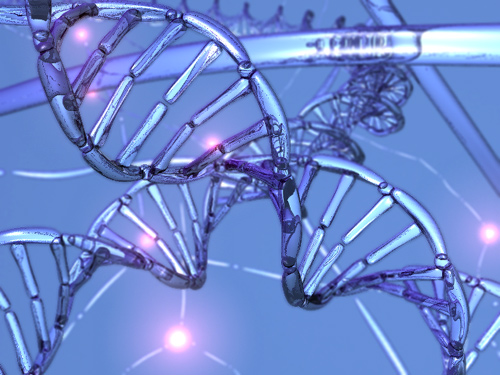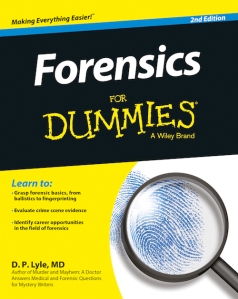GUEST POST: Understanding Mitochondrial DNA with D.P. Lyle

I’m absolutely delighted to have D.P. Lyle on my blog today! He’s an amazing writer, doctor, and forensic expert. I had the honor and opportunity to serve with him on a panel at Bouchercon 2014 to talk about forensics and the real CSI. I highly recommend that any writer, or anyone for that matter, who wants to incorporate anything about crime scene investigation and forensics into their stories to check out: Forensics for Dummies 2nd Edition.
***
Understanding Mitochondrial DNA
by D.P. Lyle
Writers ask me all sorts of questions about medical and forensic issues. Many deal with DNA, which is now widely understood by most writers. But the special type of DNA that we call mitochondrial DNA (mtDNA) still stumps many authors. It’s actually quite simple.
The DNA used for standard DNA testing is nuclear DNA, which resides only within the cell’s nucleus. It is the DNA that determines your genetic make-up, that makes you, you. Half of this comes from mom and half from dad. But, cells also contain non-nuclear DNA, which is found within the mitochondria. Mitochondria are small structures that reside within the cytoplasm (the soup) of the cell and serve as the cell’s energy production center. A small amount of DNA is found within the mitochondria and each cell has many mitochondria.
So, why is mtDNA important? Several reasons.
The most important characteristics of mtDNA are that it is passed from generation to generation by the maternal linage, mutates rarely, is exceptionally hardy, and is found in places where nuclear DNA doesn’t exist.
Your mtDNA is inherited unchanged from your mother and only from your mother. And she received hers from her mother, and her mother from her mother, and so on. Why is this? At fertilization, the egg supplies the cell and half the DNA while the sperm supplies only half the DNA. The sperm cell itself breaks down and disintegrates after passing its genetic material into the nucleus of the egg cell. This means that all the cell components of the developing zygote come from the mother. This includes the mitochondria. As the cell divides and multiplies, these mitochondria are copied and passed on, generation after generation. This means that all the cells of the body contain identical mtDNA.
Also, mtDNA rarely mutates. It is thought to undergo a significant mutation approximately once every 6500 years. Thus, it is very stable. This means that your mtDNA is virtually identical to your mother’s, your great-great grandmother, and your maternal ancestors from 1000 years ago. Thus, your maternal linage can be accurately traced over many generations. This is true of both males and females. Sons have the same mtDNA as their mother, grandmother, and so on. The difference is that daughters will then pass this mtDNA on to their children through their eggs, but sons will not—they only donate sperm to future off spring.
Let’s say a skeleton is found. It could be recent or centuries old. Nuclear DNA may not be present, but mtDNA, which is hardier, may be. Particularly within the cells of the bones or the pulp of the teeth, where mtDNA can survive for centuries. The matching of the mtDNA from the skeletal remains with a living person reveals that the two shared the same maternal ancestry. They may be sisters, mother and daughter, grandmother and granddaughter, or a remote maternal ancestor from 1000 years ago. This connection may be the clue needed to identify who the skeleton was. In forensics, the identity of a skeletal remains is crucial to solving any homicide. Why? Ninety plus percent of murders occur between people who know or are related to one another.
Lastly, mtDNA is found where nuclear DNA isn’t. Like in hair. Hair is made up of dead cells from the hair follicle. Follicle cells have nuclei and thus nuclear DNA, but when the cells die and are pushed outward as hair, the nuclei are lost. If the hair found at a crime scene has follicle tissue attached (as is often the case if it has been pulled out) then great. The ME has nuclear DNA to work with. But if it doesn’t have follicle tissue (which is the case if it simply falls out as happens every minute of every day) then there is no nuclear DNA. But the dead cells that make up the hair do contain mtDNA. So, if a murder victim is found and hair from the perpetrator is present, and the mtDNA from this hair can be matched to a person, then that person and the perpetrator must share a common maternal linage. This narrows the list of possible suspects considerably. Sometimes to one—the person the crime scene hair mtDNA was matched to.
***
NOTE: Learn more about mtDNA, DNA analysis, and the entire field of forensic science in my updated 2nd Edition of FORENSICS FOR DUMMIES, coming from Wiley February, 2016

Website: http://www.dplylemd.com
Blog: http://writersforensicsblog.wordpress.com
Crime and Science Radio: http://www.dplylemd.com/crime–science-radio.html
D.P.Lyle Bio:
 D. P. Lyle is the Macavity and Benjamin Franklin Silver Award winning and Edgar, Agatha, Anthony, Scribe, Silver Falchion, and USA Best Book Award nominated author of both non-fiction and fiction (the Samantha Cody, Dub Walker, and Jake Longly thriller series and the Royal Pains media tie-in series). Along with Jan Burke, he is the co-host of Crime and Science Radio. He has served as story consultant to many novelists and the screenwriters of shows such as Law & Order, CSI: Miami, Diagnosis Murder, Monk, Judging Amy, Peacemakers, Cold Case, House, Medium, Women’s Murder Club, 1-800-Missing, The Glades, and Pretty Little Liars.
D. P. Lyle is the Macavity and Benjamin Franklin Silver Award winning and Edgar, Agatha, Anthony, Scribe, Silver Falchion, and USA Best Book Award nominated author of both non-fiction and fiction (the Samantha Cody, Dub Walker, and Jake Longly thriller series and the Royal Pains media tie-in series). Along with Jan Burke, he is the co-host of Crime and Science Radio. He has served as story consultant to many novelists and the screenwriters of shows such as Law & Order, CSI: Miami, Diagnosis Murder, Monk, Judging Amy, Peacemakers, Cold Case, House, Medium, Women’s Murder Club, 1-800-Missing, The Glades, and Pretty Little Liars.
Welcome to
CrimeSpace
CrimeSpace Google Search
© 2024 Created by Daniel Hatadi.
Powered by
![]()
You need to be a member of CrimeSpace to add comments!